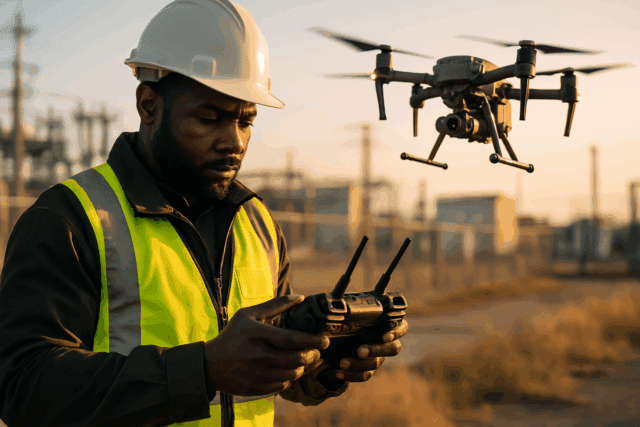The rapid proliferation of Unmanned Aerial Systems (UAS), commonly known as drones, has revolutionized surveying and mapping, offering unprecedented efficiency and detail in data collection. From infrastructure inspection to topographical mapping, drones capture vast amounts of high-resolution visual and geospatial data. However, this technological leap also ushers in a critical challenge: ensuring the robust security of the sensitive data collected throughout drone survey operations. Neglecting drone data security can lead to significant risks, including intellectual property theft, privacy breaches, reputational damage, and non-compliance with evolving regulations.
Understanding the Drone Data Security Landscape
Drone survey operations involve a complex data lifecycle, from capture to transmission, storage, and processing. Each stage presents unique vulnerabilities that require a multi-layered security approach. Identifying potential threats is the first step in building a resilient defense. These threats can range from cyber-attacks and signal interception to physical risks like drone theft or loss.
Common Threats to Drone Data
- Cyber-attacks: Hackers may attempt to intercept data during transmission, manipulate flight control commands, or exploit vulnerabilities in the drone’s software or firmware.
- Signal Jamming and Spoofing: Intentional interference can disrupt communication links between the drone and its ground control station, potentially leading to loss of control or data interception. GPS spoofing can mislead a drone about its location.
- Unauthorized Access: If storage devices on the drone or ground station are not adequately protected, data can be vulnerable to unauthorized access or theft.
- Physical Theft or Loss: A lost or stolen drone with unencrypted onboard storage can result in sensitive data falling into the wrong hands.
- Insider Threats: Malicious actors within an organization can compromise data if access controls are not stringent enough.
- Supply Chain Vulnerabilities: Drones and their components sourced from untrusted manufacturers can introduce backdoors or weaknesses, posing national security risks.
Implementing Robust Security Measures Throughout the Data Lifecycle
A comprehensive data security strategy for drone survey operations must address each phase where data is handled.
Secure Data Capture and Onboard Management
Protecting data at the source is paramount. Drones store images, videos, and flight logs on internal memory or removable storage devices like SD cards.
- Onboard Encryption: All sensitive data collected should be encrypted directly on the drone’s storage media using robust encryption features, such as AES 256-bit encryption. Some drones offer password protection for onboard storage and SD cards.
- Physical Security: Mechanisms to protect data stored directly on the drone should include password protection for onboard storage and SD cards.
- Data Minimization: Only collect necessary data, and implement software features that limit data collection and retention. For instance, restrict data collection once the drone leaves its predetermined path and automatically erase data after downloading when possible.
Secure Data Transmission
Data in transit between the drone and the ground control station (GCS), or to cloud services, is a critical vulnerability point.
- Strong Encryption Protocols: Utilize strong encryption protocols like AES-256 for all communications, including video transmissions, GPS coordinates, and flight control commands. HTTPS and SSL/TLS are also used for web-based interactions and real-time data exchange.
- Secure Communication Channels: Employ secure file transfer protocols (SFTP, HTTPS, TLS) and Virtual Private Networks (VPNs) to create secure tunnels for data exchange, significantly reducing interception risks.
- Local Data Mode: For some foreign-manufactured drones, enabling “Local Data Mode” (LDM) can help block data from being transmitted or shared to external servers, allowing for offline operation.
- Authentication Mechanisms: Verify the identity of users and devices to prevent unauthorized access to drone controls or sensitive data.
Robust Data Storage and Management
Once data is off the drone, its security depends on the storage solutions and management practices.
- End-to-End Encryption: Ensure data remains encrypted when stored in cloud platforms or on-premises solutions. Cloud providers often offer advanced data protection measures, including encryption and redundancy. FIPS-compliant secure storage devices are recommended.
- Secure Cloud Platforms: Opt for cloud solutions with end-to-end encryption, data redundancy, firewalls, and compliance certifications like SOC2 Type II and ISO27001. DJI, for example, uses AWS and Alibaba Cloud with multi-layer protection and AES-256-CBC encryption for sensitive information.
- Access Controls: Implement strict access controls, including multi-factor authentication (MFA) and role-based access control (RBAC), to ensure only authorized personnel can access drone data and systems. Default passwords should always be changed to strong, unique ones.
- Data Retention Policies: Establish and adhere to data retention policies to minimize the risk of unauthorized access to sensitive information by deleting data when no longer needed, in compliance with regulations.
- Decentralized Storage: In some secure systems, encrypted drone data is transmitted to a central command and stored in a decentralized manner across secure servers to ensure data redundancy and availability.
Protecting Data During Processing and Analysis
Even during internal processing, data can be vulnerable.
- Isolated Processing Environments: Process sensitive data in secure, isolated environments to prevent leakage.
- Data Anonymization/Obfuscation: Where possible and appropriate, anonymize or de-identify personal data, especially if public disclosure is not essential.
- Regular Security Audits: Conduct regular security assessments, including penetration testing and vulnerability scans, to identify and mitigate potential weaknesses in processing systems.
- AI System Security: For AI-driven drone systems, protect against algorithm manipulation, data breaches, and navigation control weaknesses. This includes using AI-powered threat detection and secure communication protocols.
Regulatory Compliance and Ethical Considerations
The regulatory landscape for drone operations and data handling is rapidly evolving, particularly concerning privacy.
- Data Protection Laws: Comply with relevant data protection laws such as GDPR in Europe, which imposes strict requirements on the collection and processing of personal data. Many countries and regions have specific laws regarding drone surveillance and privacy.
- Privacy Impact Assessments (PIAs): For professional and commercial use, organizations should perform robust Privacy Impact Assessments to assess their compliance with data protection laws.
- Transparency and Consent: Notify individuals about UAS operations, the purposes of data collection, and the operator’s identity. Obtain consent for processing personal data unless exceptions apply.
- Respecting Privacy: Avoid flying over private property without permission and refrain from gathering personal data without a clear reason. If sensitive data about individuals is collected, it must be secured.
- Firmware and Software Updates: Regularly update drone firmware and software to close security gaps and enhance encryption measures, as outdated software is a frequent target for cyberattacks.
- Supply Chain Security: Prioritize drones and components from secure, trusted supply chains to avoid national security threats and data exfiltration risks posed by untrustworthy foreign manufacturers.
Future Trends in Drone Data Security
As drone technology advances, so too will the methods for securing data.
- Quantum Cryptography: Offers unprecedented security by leveraging quantum mechanics principles.
- Blockchain Integration: Provides decentralized, tamper-proof methods for managing encryption keys and ensuring data integrity.
- AI-Driven Security: Artificial intelligence can be used to identify vulnerabilities, adapt encryption protocols in real-time, and detect malicious drones or suspicious activities in the network.
- Private 5G Networks: Offer enhanced security, high-speed data transfer, and ultra-low latency for drone operations, underpinning automated systems.
- Lightweight Cryptography: As drones often have limited processing power and energy reserves, lightweight cryptographic solutions are emerging to protect UAV data exchanges without significant performance overhead.
Ensuring data security for drone survey operations is an ongoing commitment requiring vigilance, continuous adaptation to new threats, and adherence to best practices and regulatory guidelines. By implementing a multi-layered security strategy that encompasses every stage of the data lifecycle, organizations can harness the transformative power of drones while safeguarding sensitive information and maintaining public trust.





